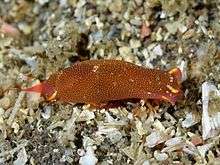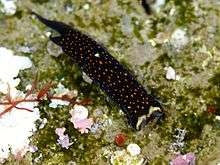Chelidonura fulvipunctata
| Chelidonura fulvipunctata | |
|---|---|
| Scientific classification | |
| Kingdom: | Animalia |
| Phylum: | Mollusca |
| Class: | Gastropoda |
| Clade: | Heterobranchia |
| Clade: | Euthyneura |
| Clade: | Euopisthobranchia |
| Order: | Cephalaspidea |
| Family: | Aglajidae |
| Genus: | Chelidonura |
| Species: | C. fulvipunctata |
| Binomial name | |
| Chelidonura fulvipunctata | |
| Synonyms[2] | |
Chelidonura fulvipunctata, the white-speckled headshield slug,[5] is a species of sea slug or headshield slug, a marine opisthobranch gastropod mollusc in the family Aglajidae. This species is widespread in the Indian and Pacific Oceans but has invaded the Mediterranean Sea since 1961, despite apparently being absent from the Red Sea until recorded there in the 21st century.
Etymology
The generic name Chelidonura means "swallow-tail" referring to the two lobes which extend out from the back of the mantle shield,[6] while the specific name fulvipunctata is a compound meaning tawny or dull yellow (fulvus) and spotted (punctata).[7]
Distribution
Chelidonura fulvipunctata is widely distributed in the western Pacific from Mexico and Hawaii west to Japan[7] and the east coast of Australia and Lord Howe Island,[8] through Indonesia and the tropical Indian Ocean to the Mascarene Islands, Mozambique and South Africa.[7] It is rare in the Mediterranean where it was first recorded in 1961 off Turkey but it has now been recorded off the France, Balearic Islands, Malta, Cyprus and Israel.[7] It was recorded in the Red Sea for the first time in 2005, most likely as a result of anti-Lessepsian migration,[9] although it is possible that C. fulvipunctata entered the Mediterranean through the Suez Canal from the Red Sea.[7] The most likely source of C. fulvipunctata reaching the Mediterranean is transport on shipping, the original discovery site of C. fulvipunctata in the Mediterranean being a former traditional boat building locale in southern Turkey which is popular with recreational yacht sailors.[10] It was reported from Canary Islands in 2016.[11]
Description
An elongated, somewhat cylindrical gastropod, C. fulvipunctata has an internal, very thin shell. Its body is divided into a cephalic shield and a visceral hump which is, partly covered by a posterior mantle shield. The cephalic shield has its anterior edge wider than the posterior point and it is roughly divided. The eyes are situated on the front of the head and almost invisible as they are obscured by the dorsal surface. The mouth is flanked on either side by a mound which is covered in sensory bristles. The animal's foot is expanded into two lateral parapodia. The two long and symmetrical parapodia fold over and partially cover the dorsal surface. A pair of tapering lobes extend from the rear of the mantle shield, the left one is longer while the right lobe is much shorter.[6]
This species typically has a background colour of black or dark brown with a bluish sheen marked with yellowish or orange spots, although some specimens are reddish brown with small yellow spots. A distinguishing feature is a white mark shaped like the letter w across the anterior edge of the head, although this may only be partially visible on some specimens, and a white or pale yellow crescent-shaped spot at the posterior edge of the head shield.[7][12] They are normally between 10–20 millimetres (0.39–0.79 in) in length[6] and in Australia they do not normally exceed 18 millimetres (0.71 in)[12] but in the Mediterranean specimens of 33 millimetres (1.3 in) have been recorded.[6]
 Chelidonura fulvipunctata in black with small spots. |
 C. fulvipunctata in reddish brown with small yellow spots. |
 C. fulvipunctata with a spot at the posterior edge of the head shield. |
Biology

The preferred habitat is rocky or sandy areas with large amounts of algal debris from the low water mark to 20 metres (66 ft) in depth; it can occur in both sheltered and exposed sites. It is nocturnal and like other species in the genus Chelidonura it is known to feed on small polychaete worms and acoelomate flatworms, prey is detected using the sensory mounds on either side of the mouth.[8] The eggs are laid in strings covered in mucus, debris adheres to the mucus strengthening and camouflaging the strings of eggs. In laboratory conditions the eggs hatch in four days.[7] The few specimens found in the Mediterranean have been found under stones at 3 metres (9.8 ft) depth and on rocky substrate at 12 metres (39 ft) in depth.[6]
References
- ↑ Baba K. (1938). "Opisthobranchia of Kii, Middle Japan". Journal of the Department of Agriculture, Kyusyu Imperial University, 6(1): 1–19.
- ↑ "Chelidonura fulvipunctata Baba, 1938". World Register of Marine Species. Bouchet, P. Retrieved 29 December 2016.
- ↑ Burn R. (1966). "Some opisthobranchs from southern Queensland". Journal of the Malacological Society Australia 1(9): 99–109.
- ↑ Swennen C. (1961). "On a collection of Opisthobranchia from Turkey. Zoologische Mededelingen 38(3): 41–75. PDF.
- ↑ "White-speckled Headshield Slugs, Chelidonura fulvipunctata". MarineBio Conservation Society. Retrieved 30 December 2016.
- 1 2 3 4 5 "Chelidonura fulvipunctata". CIESM. Retrieved 29 December 2016.
- 1 2 3 4 5 6 7 "Chelidonura fulvipunctata". OPK – Opistobranquis. Miquel Pontes, Manuel Ballesteros, Enric Medrenas et al. Retrieved 30 December 2016.
- 1 2 "Chelidonura fulvipunctata (Baba, 1938)". Solitary Islands Underwater Research Group Inc. Retrieved 30 December 2016.
- ↑ Manuel António E. Malaquias; Andrea Zamora-Silva; Dyana Vitale; Andrea Spinelli; Sergio De Matteo; Salvatore Giacobbe; Deneb Ortigosa; Juan L. Cervera (2017). "The Suez Canal as a revolving door for marine species: a reply to Galil et al. (2016)(in press – Published online: 22 November 2016)" (PDF). Aquatic Invasions. 12. Archived from the original (PDF) on 30 December 2016.
- ↑ Manuel António E. Malaquias; Andrea Zamora-Silva; Dyana Vitale; Andrea Spinelli; Sergio De Matteo; Salvatore Giacobbe; Deneb Ortigosa; Juan L. Cervera (2017). "The Mediterranean Sea as a gateway for invasion of the Red Sea: the case of the Indo-West Pacific head-shield slug Chelidonura fulvipunctata Baba, 1938" (PDF). Aquatic Invasions. 11 (3): 247–255.
- ↑ Herrero-Barrencua A., Moro L. & Ortea J. (2016). "Primeros registros de Chelidonura fulvipunctata Baba, 1938 y Diaphorodoris papillata Portmann & Sandmeier, 1960 (Mollusca: Heterobranchia) en las islas Canarias. Firsts records of Chelidonura fulvipunctata Baba, 1938 and Diaphorodoris papillata Portmann & Sandmeier, 1960 (Mollusca: Heterobranchia) in the Canary Islands". Vieraea 44: 121–126.
- 1 2 "Chelidonura fulvipunctata Baba, 1938". Sea Slug Forum. Retrieved 29 December 2016.
External links

